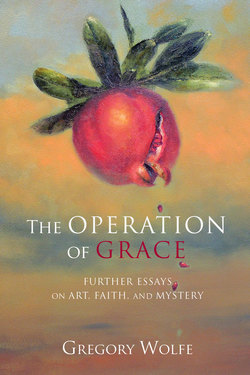Читать книгу The Operation of Grace - Gregory Wolfe - Страница 14
На сайте Литреса книга снята с продажи.
Secular Scriptures
ОглавлениеAny new book about the relationship between the Bible and literature enters a crowded field, one strewn with masterworks by the likes of Robert Alter, Frank Kermode, Northrop Frye, and Gabriel Josipovici. So the bar is set high. Nicholas Boyle’s Sacred and Secular Scriptures: A Catholic Approach to Literature clears that bar with room to spare. While the subtitle might put some readers on guard, Boyle proves a hospitable and respectful writer; at points the Catholic tradition takes center stage, but much of the book speaks with equal power and resonance to Jewish and Protestant traditions.
There is no disguising the intellectual rigor of Sacred and Secular Scriptures, which contains a survey of modern biblical interpretation and close readings of several literary classics. Boyle is aware that some will be daunted by those sections of the book, so he makes the generous suggestion that readers pick and choose what to read. Impractical as that suggestion may be, I for one endorse it. The brief central section, “Sacred and Secular,” could stand alone as a major contribution to the fields of theology, literary criticism, and aesthetics.
Drawing on the thought of Paul Ricoeur and Emmanuel Levinas, Boyle explores the ways in which both the Bible and secular literature might be understood as forms of revelation. Following Ricoeur, he defines revelation as “the manifestation to us of something that utilitarian reason could not possibly predict or infer or construct.” In saying this, Boyle neither seeks to collapse the Bible into poetry or to undermine the historicity of any part of the Scriptures. What he does assert is that the two forms of writing involve poetic language that is nonpurposive and noninstrumental, words that:
in different ways assert our freedom from the tyranny of functional, goal-directed thought and language: secular literature by using words to give pleasure and so enabling us to enjoy what is; sacred literature by using words to utter obligation, and so to give us our identity, not as beings who perform a function, but as creatures who know what ought to be.
Boyle is clear about what distinguishes the two forms of writing. The Bible reveals the fundamental moral obligation of the Law, the command that we love and care for the other. Secular literature, using the playful, entertaining forms of art, attempts to tell the truth about who we are and how we live. It cannot speak with the authority of divine revelation because it can be traced directly to individual authors, who are subject to historical and cultural contingencies in a manner that the Bible is not. Boyle relates the difference between sacred and secular literature to Kant’s distinction between the beautiful and the moral: “the beautiful may be a symbol of morality, but the relation of symbolization implies difference and noncommensurability too.”
Alike and yet incommensurable. Where, then, is the overlap between these forms of revelation? If there is “no literary simulacrum of the Law,” as Boyle states, what relationship does secular literature have to divine truth?
To answer these questions, Boyle examines the nature of literary representation. The pleasure we take in literary mimesis, in the imitation of the world around us, lies in the public dimension of art. As Aristotle noted, the value of tragedy is the way it brings its viewers into a shared experience of grief and loss. In short, life matters. As Boyle puts it, “we are in it together.”
In this sense, literature becomes “the secular analogue of the Redemption.” Whether it is in the characters depicted in fiction and drama, or the persona of the speaker in poetry and creative nonfiction, literature tells the truth about both our noble origin and our fallenness. It represents a world worth loving and in need of forgiveness. Only in this way can literature be moral without being didactic.
Secular literature provides a commentary on the Bible. But here Boyle points out an interesting twist. It is in the nature of literary representation, he says, to strive for the appearance of the same authorlessness that characterizes sacred Scripture. “‘These words are not being spun out of a mind, they tell truth’ is the fiction, the lie, Plato would say, with which all fictions begin.”
The tension at the heart of literature is between that striving for authority and an awareness of the limitations of the individual writer. In the third part of his book, Boyle traces this tension in Pascal’s Pensées, Goethe’s Faust, Melville’s Moby-Dick, and Austen’s Mansfield Park. Each of these works is modern, created at a time when the process of secularization in the West had begun. And so they serve as test cases for the existence of the secular as commentary on the sacred.
What Boyle finds in these works is the struggle against the limitations of secularity, one he detects in their difficult and enigmatic endings. But instead of seeing such conflicts as deconstructing the possibility of meaning, as a postmodern critic might, Boyle sees them in a more positive light:
Read as showing Christ in the moment in which they mark themselves off from God, secular scriptures become the limit case of sacred scripture, the word of God no longer as an address to us—as God’s reply to our prayer—but as the inarticulate groanings of the spirit within us—as our prayer itself.
A summary this abbreviated inevitably does an injustice to the original. Its virtue, I hope, is that it will send you to the source.
